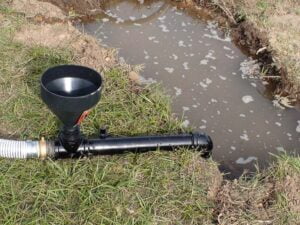A Comprehensive Overview of Drilling Mud
The Lone Star Drills water well drill line uses mud rotary drilling, which relies on properly mixed drilling mud. Here’s how to prepare your drilling mud for your project.
 What is drilling mud?
What is drilling mud?
In the drilling community, the term “drilling mud” or “mud” refers to a carefully engineered drilling fluid that helps stabilize the borehole. This heavy, viscous mixture carries soil and rock cuttings to the surface of the borehole and lubricates the drill bit.
Mud is typically a combination of water with bentonite, a type of clay. When used to create drilling mud, bentonite changes the viscosity and pH levels of the water to make it more suitable for mud rotary drilling.
When should you prepare drilling mud?
Mix drilling mud and set it aside before starting the project. We recommend mixing the mud in a large trash can or 55-gallon drum before transferring it into the drilling pits.
To mix the bentonite and water, circulate it through the mud pump for at least 30 minutes to reach the proper consistency and fully hydrate the bentonite. The proper mixing times will depend on the required viscosity of the mud and the water’s pH levels.
What is viscosity?
Scientifically, viscosity is a term used to explain liquid “thickness.” A good example is that syrup has a higher viscosity than water. And, like with syrup thickness and fluidity, viscosity can change based on temperature and pressure.
Drilling mud viscosity is important because fluid with a higher viscosity pushes harder against the soil or stone. The goal is to have a high enough mud viscosity to lift the drill cuttings out of the borehole and into the mud pits.
How do you increase the viscosity of drilling mud?
Keep extra bentonite mixture on hand while drilling in case more needs to be added at a later time. Throughout the mud rotary drilling process, assign a person to monitor the mud. That person needs to be ready to quickly adjust the viscosity to match drilling conditions by adding more bentonite or water to the drilling pits. Without proper monitoring, cuttings can build up in the borehole and the bit can become stuck.
Why is the water’s pH level important?
Water is an essential component of a mud rotary drilling project. The pH level of the water needs to be tested before drilling starts to make sure the water is safe for the drill. The World Health Organization’s standard for water pH levels is between 6.5 and 8.5. If the water’s pH level is less than 6.4, it may be corrosive to metal pipes and may leach metals from the pipe into the water. Water with a pH level higher than 8.5 tends to leave salt deposits on fixtures.
Testing strips are available for checking the pH levels before you drill. The test takes less than a minute to complete and can help ensure the water is safe for your drill and the water well.
Learn More
To learn more about drilling mud and what kind of bentonite mixture should be used in your drilling project, reach out to Lone Star Drills’ mud rotary drilling experts today!